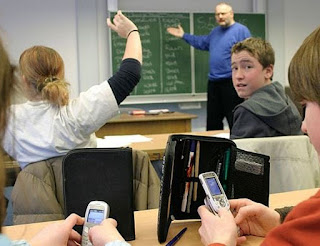Teachers have a hard time competing with cell phones for their students' attention.
As a teacher, you're probably used to students not paying attention in class. But a study by the University of Houston found that even when teachers are actively engaging their students and presenting engaging material, cell phones can still be more interesting than your lesson plan. Students' phones are personalized and often have games and contact with friends on them. They also offer constant distraction: if one student is on their phone during class, other students may feel like they need to check their own devices too.
In addition, it's not just about competition with cell phones—teachers can be less interesting than cell phones themselves! Many people find teachers boring because they're used to interacting online through social media platforms or texting friends instead of speaking face-to-face in class. Additionally, many young people don't have much respect for authority figures anymore because society has become so open and liberal; if you try telling a teenager not to use their phone in school now, chances are good that they won't listen or care what you say at all!
Is It Right For Schools to Block Cell Phone Reception?
Cell phones are tools of the future.
You can use them to connect with students. Students and teachers often communicate via text messages, email, or social media. This allows you to communicate with your students outside of class time and gives them a way to reach out if they have questions or concerns about their work (or even just want some encouragement).
You can use them as an engaging tool in the classroom. If a student is bored or distracted by something that you're teaching, allow them to check their phone and then ask them how it relates back to the lesson at hand when they return their attention back to you and your lesson plan!
They can be used for assessment purposes so that teachers know which areas need more attention when working with each student individually after class periods end by using data collected through multiple assessments throughout different components like quizzes/exams etc...
Cellphones make research easier than ever before! Teachers will no longer have problems finding sources quickly because everything is right there on hand thanks on those handy little devices called "smartphones."
Teachers say that when they use cell phones in class, it changes their teaching style.
Teachers say that when they use cell phones in class, it changes their teaching style. The teacher must learn to use mobile technology to teach effectively; they must be willing to learn about new technology and be willing to change their teaching style if necessary.
Cell phone learning apps are being developed to make learning more fun and interactive.
Learning apps are being developed to make learning more fun and interactive.
Learning apps have been around for a long time, but they're becoming increasingly popular with students who want to learn on their own time. Not all learning apps are available for every operating system, such as Android or iOS (the operating systems for mobile phones). Some apps are free, while others cost money. Some are designed for teachers only; some are designed for students only (or both). Learning apps can help students focus and pay attention when using their cell phones for schoolwork, which can give them an edge over other kids who don't use this technology properly in class or at home. Teachers can monitor student progress through these applications if they wish to do so; this is especially helpful if there's an issue with discipline at school where certain types of behavior may need additional attention from administrators as well as parents!
Classroom learning and mobile phone use can go hand in hand, but it depends on the way mobile phones are used in the classroom.
In a classroom setting, there are many ways to use mobile phones as learning tools. Mobile devices can be used for taking notes and creating presentations, for example. Teachers can also create apps that harness the power of mobile devices and make them even more useful in the classroom setting. For example, an app might allow students to research topics and then share their findings with other students on the fly. In this way, teachers can incorporate technology into their curriculum while still maintaining control over what students access and how they use it in class.
The key to getting student attention is not banning all cell phone use during class time; instead, teachers should focus on when they want their students’ attention (i.e., during lectures) and develop strategies for making sure that happens without interrupting learning opportunities or causing distractions (i.e., having someone else take attendance).

